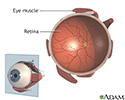Central serous choroidopathy
Central serous retinopathy
Central serous choroidopathy is a disease that causes fluid to build up under the retina . This is the back part of the inner eye that sends sight information to the brain. The fluid leaks from the blood vessel layer under the retina. This area is called the choroid.
Retina
The retina is the light-sensitive layer of tissue at the back of the eyeball. Images that come through the eye's lens are focused on the retina. Th...

Causes
The cause of this condition is unknown.
Men are affected more often than women, and the condition is most common at around age 45. However, anyone can be affected.
Stress appears to be a risk factor. Early studies found that people with aggressive, "type A" personalities who are under a lot of stress may be more likely to develop central serous choroidopathy.
The condition can also occur as a complication of steroid drug use.
Symptoms
Symptoms may include:
- Dim and blurred blind spot in the center of vision
- Distortion of straight lines with the affected eye
- Objects appearing smaller or farther away with the affected eye
Exams and Tests
Your health care provider can most often diagnose central serous choroidopathy by dilating the eye and performing an eye exam. Fluorescein angiography confirms the diagnosis.
Fluorescein angiography
Fluorescein angiography is an eye test that uses a special dye and camera to look at blood flow in the retina and choroid. These are the two layers ...

This condition may also be diagnosed with a noninvasive test called ocular coherence tomography (OCT).
Treatment
Most cases clear up without treatment in 1 or 2 months. Laser treatment or photodynamic therapy to seal the leak may help restore vision in people with more severe leakage and vision loss, or in those who have had the disease for a long time.
People who are using steroid drugs (for example, to treat autoimmune diseases) should stop using these drugs, if possible. DO NOT stop taking these medicines without first talking to your provider.
Outlook (Prognosis)
Most people recover good vision without treatment. However, vision is often not as good as it was before the condition occurred.
The disease returns in about half of all people. Even when the disease returns, it has a good outlook. Rarely, people develop permanent scars that damage their central vision.
Possible Complications
A small number of people will have complications from laser treatment that impair their central vision. That is why most people will be allowed to recover without treatment, if possible.
When to Contact a Medical Professional
Call your provider if your vision gets worse.
Prevention
There is no known prevention. Although there is a clear association with stress, there is no evidence that reducing stress can help prevent or treat central serous choroidopathy.
References
Pulido JS, Kitzmann AS, Wirostko WJ. Central serous chorioretinopathy. In: Yanoff M, Duker JS, eds. Ophthalmology . 4th ed. Philadelphia, PA: Elsevier Saunders; 2014:chap 6.30.
Roddy GW, Rosa RH, Jr. Pathology of the retina. In: Tasman W, Jaeger EA, eds. Duane's Foundations of Clinical Ophthalmology . Vol. 3. Philadelphia, PA: Lippincott Williams & Wilkins; 2013:chap 13.
-
Retina - illustration
The retina is the internal layer of the eye that receives and transmits focused images. The retina is normally red due to its rich blood supply.
Retina
illustration
Review Date: 8/20/2016
Reviewed By: Franklin W. Lusby, MD, ophthalmologist, Lusby Vision Institute, La Jolla, CA. Also reviewed by David Zieve, MD, MHA, Isla Ogilvie, PhD, and the A.D.A.M. Editorial team.

